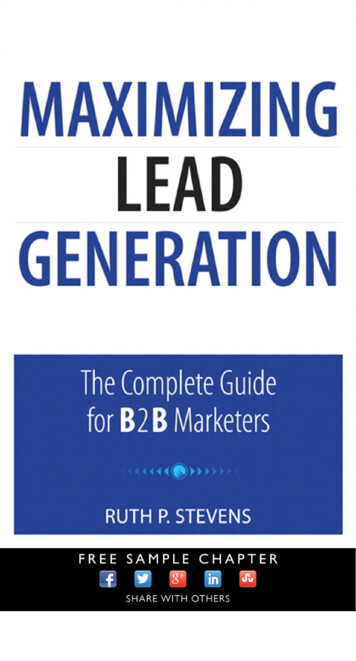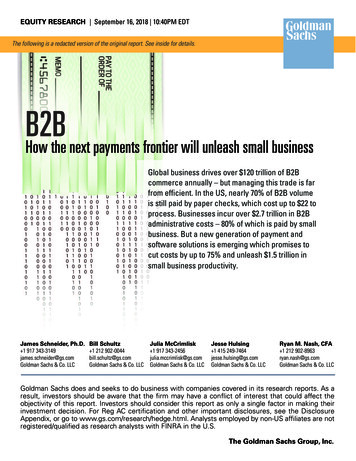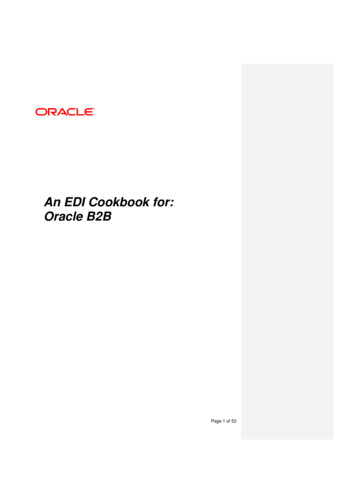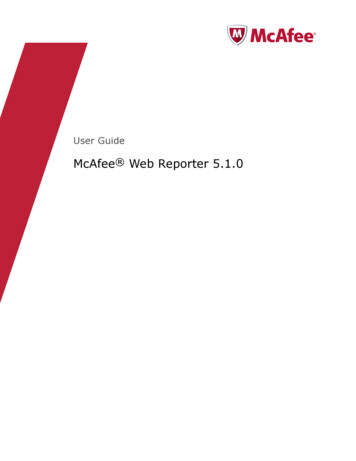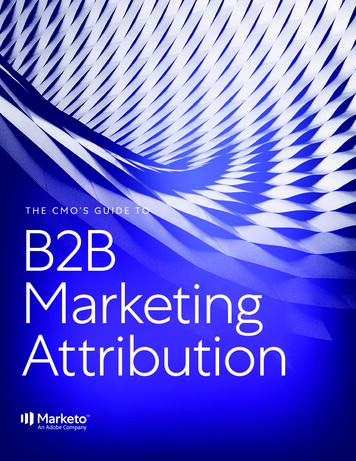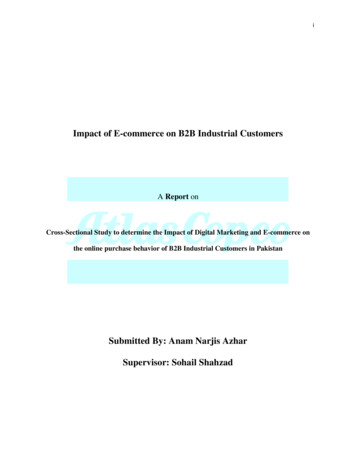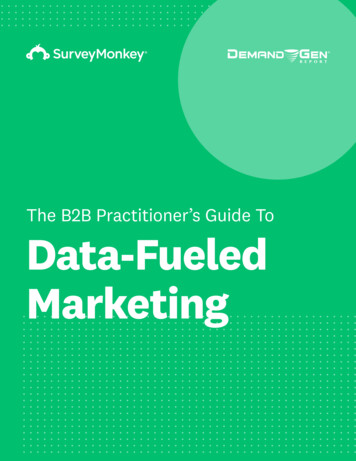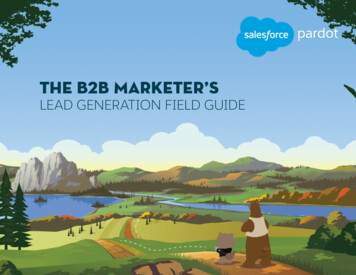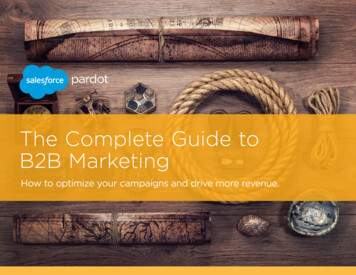
Transcription
B2B Segmentation SolutionsUnderstand market opportunities to grow your customer baseOctober 2009
B2B Segmentation SolutionsUnderstand market opportunities to grow your customer baseExecutive summaryWith business-to-business (B2B) marketersunder increasing pressure to better targettheir customers and prospects, segmentationcan be a powerful tool for strategic andtactical applications. But too many B2Bsegmentation approaches fail to delivertheir promise in the marketplace. Whilemarketing segmentation systems have enjoyedwidespread acceptance in the consumerworld for decades, similar systems for B2Bmarketing have languished due in part tothe limited availability of accurate data andtechnical expertise. All too often, custommodels can’t be implemented at the streetlevel and are useless for developing highquality leads, delivering targeted marketingor creating differentiated messages.New methodologies for modeling dataare yielding innovative B2B segmentationsolutions that are both actionable andeffective. Enhanced datasets and segmentationtechniques developed by The NielsenCompany are helping companies developinformed strategies for prospecting newcustomers, re-aligning sales territories,cross-selling existing customers and predictingfuture opportunities. Their techniques uncoverkey attributes of a company’s most valuablebusiness customers and then employ themusing a segmentation approach to helpfocus their marketing efforts and increasesales. While B2B segmentation is still arelatively new discipline, the results havealready proven their value and led to a numberof best practices to help ensure success.Page 2IntroductionThe challenge for marketers has always beenthe same: know your customer. But withlimited information on most companies—especially small and mid-sized firms—marketers traditionally have concentratedtheir efforts in the consumer world whereample data exists to craft effective targetmarketing solutions. Analysts can accessdemographic data from the U.S. CensusBureau (“householders age 34-54 withincomes over 100,000”), product salesstatistics from marketing companies (“buyersof Tide but not Wisk”) and all manner ofbehavioral and psychographic researchfrom survey houses (“early adopters” or“eco-consumers”). When all these data aresliced and diced to create consumer types,the resulting segmentation systems—likelifestyle-based Nielsen PRIZM—becomepowerful off-the-shelf tools for consumertarget marketing.For B2B marketers however, getting to knowtheir end buyers is not so simple. Unlikedemographic data, accurate informationabout businesses—so-called firmographicdata—has been harder to come by, in partbecause of the life cycle of business establishments. According to the Small BusinessAdministration, more than half of all newbusinesses fail within their first four years.And with more than 1.25 million businessesstarting up and shutting down each year,market researchers are left with a confusionof addresses, phone numbers and staff titlesthat make tracking difficult. In addition,most private companies don’t publishdetailed financials such as annual revenue,earnings and profit margins. Analysts insteadmust estimate this data using custommodels with results that routinely reinforcethe adage “garbage in-garbage out.”Fortunately, B2B marketers are now gettingtheir due. Comprehensive databases suchas Nielsen Business-Facts give marketersaccess to accurate and current data within aconsistent framework on 13 million businessestablishments—critical information such asa company’s total headcount and industryclassification Standard Industrial Classification(SIC) or North American Industry ClassificationSystem (NAICS) code. By appending thesedata to its business customer file, a companycan create a robust business segmentationapproach that can guide all its marketinginitiatives, including prospecting, sales territorymapping, advertising and target marketing.In a typical segmentation analysis, businesscustomers are sorted into categories basedon company size and industry, though otherdefining characteristics could also be added.Using figures from a proprietary databaseand their own information, analysts calculatesales per employee within each business,estimate its market potential value andrank it against all other customers andprospects. At that point, the applicationsare limited only by a marketer’s imagination.Analysts can forecast the size of an opportunityand benchmark penetration rates within anindustry segment. Core customers can betargeted for up-selling while high potentialprospects are assigned a dedicated sales staff.The management team can set performancetargets, redraw sales territories and reclassifyprospects if the segmentation analysis indicatesa large, unrealized potential, see figure 1. 2009 The Nielsen Company. All rights reserved
B2B Segmentation SolutionsAFTER Segmentation AnalysisBEFORE Segmentation AnalysisFigure 1: Realigning sales territories based on segmentation analysisBusiness segmentation can help companies align their sales territories based on the opportunitieson the ground. The BEFORE map shows territories determine by geometry—four quadrants dividingthe central area—while the AFTER map shows territories that vary in size based on the number andpotential value of target businesses (the red dots indicating the locations of target businesses). Bymapping its business prospects by size and industry type in Lexington, Kentucky, a company canbetter realign its sales territories based on the concentrations of its high-quality prospects.Source: Nielsen Business-FactsBusiness segmentation can also drivechanges to marketing communications andadvertising. Instead of relying on intuitionand tradition—using the same channelsand messages that have been around fordecades—marketers can develop initiativesbased on hard data that address the needsof their business customers and reach themin the way they will be most receptive, seefigure 2.Page 3With current economic conditions putting thesqueeze on budgets, business segmentationcan deliver more bang for the marketingbuck, helping companies cost-effectivelyretain their best customers and find lucrativenew prospects. As with B2C marketing, thecompanies that are succeeding are the onesthat use B2B segmentation solutions tocreate offerings and communicate messagesthat resonate with their business customers.Can you hear them now:Uncovering new opportunitiesAcquiring new customers is a perennialchallenge for most companies, but it isvital for growing the business. Like manycompanies serving mostly rural America,Windstream Communications struggledwith identifying lucrative small businessprospects in its 16-state footprint. Atelecommunications company serving threemillion customers—one million of thembusiness establishments—Windstream didn’thave a systematic way to prioritize prospects,a strategy for packaging its services or evena protocol for initiating contact with companies.Individual sales people approached eachnew business customer differently, typicallyoffering Windstream’s phone, broadbandand data services based on the number ofrequested phone lines.This catch-as-catch-can approach didn’t allowWindstream to develop an understandingof the prospect’s profit potential or itspotential wallet share. A small firm signingup for 200 in telecom services fromWindstream may already be spending 800 at another company. “We had noway of knowing whether there was a hugeopportunity left on the table,” says MichaelBek, Director of Direct Marketing atWindstream, in Little Rock, Arkansas.“Without knowing where the money was,we couldn’t prioritize where our salesdepartment should focus its attention.”To improve that understanding, Windstreamworked with Nielsen analysts to create asegmentation system that classifies itsbusiness customers into segments anddetermines the opportunity of each segment.Windstream’s existing customer recordswere first matched against the NielsenBusiness-Facts database to identify eachcompany’s SIC code and employee count.Analysts then divided the companies intothree buckets based on size: small firms withfewer than 10 employees, medium-sized 2009 The Nielsen Company. All rights reserved
B2B Segmentation SolutionsFigure 2: Differentiated messages based on segmentation analysisCold Hard Cash.Your growing trucking business thrives on it.Our job is to help you make it work harder for you.Dear Mr. Smith:With our Cash Management Services, we’ll help you boost cash flows, reducecosts and provide you with more financial leadership for your trucking business.Whether you're looking to buy equipment or simply need working capital,we’ll provide you with the financing options to solve your growing challenges.srdawg reJ&B Bank offers a full range of receivables, payables and liquidity servicesrt earninw to sta!to help you drive the success of your large business. It’s how we can helpReply no siness spending 0092u,br15uroeyyou make a wise decision.forvembapires Nohat’s whyOffer Exan ever. T can earntht:anerrtnou With years of experience helping other businesses, we understand this ispwyoOim,serreesomns is mcustoall Busiyour business, and you deserve individual attention. We'll take the time toDear Sm ey for your busines elp. As our valued tes.onnht raput together the best financing package available, with an amount andSaving m siness Account ca ual fees and greanuBanBnonew J&term that suits your business. And we’ll do it at a competitive rate so youices withrvrdsercafoitedrewardscan take comfort in knowing that your large business may soon becomesiness crubruosingunt larger—without breaking the bank.elf for u tscorsacurouyyoRewardicearged toonus poinrst-use b for each dollar ch and Internet serv 5,000 fikneFocus on relationship building while we take care of the financingoachbpllshceca,t 1 percen ints on restaurants Lines of credit for working capital needspolebuoD it line Term loans for the purchase of equipment, vehicles or machineryansedlocrsszeesinusinnessernizatio Letters of credit to insure you’ll always have access to a high cash outlayney on bith a busiSave mo cing flexibility w pansion and modExplore our innovative cash management services to increase your salesanexnrfifoy0jo0 En Tax-payment services to manage IRS requirementsto 250,0 siness00,52 uof b Getprovide you with assistance to expand your enterprise SBA loans thatnew lineseslarge or Develop costs, points or feneeds—servicesto. cut down on your fixed expenseskin gPayrollayangdbnrtosiullocal yo No clsite oraccounts Sweepto put your excess cash to work earning interestves for al sit our weberesdses, visine your bu k business servicesicrvseeGet thB BanTogether, these services may help your business to improve its cash flowrequest J&small. Tomanagement. To request J&B Bank cash management services, visit ourwebsite or call today.,SincerelyanmaphCW.Sincerely,hapmanWilliam C tions ManagerW. ChapmanluSoBusinessWilliam ChapmanBusiness Solutions ManagerAfter classifying its business prospects into different segments, a company can differentiate itsmarketing messages based on the needs of each recipient. These letters address two very differentsegments: one for small retail establishments like bakeries or clothing boutiques (left) and anotherfor large industrial companies like trucking businesses or cement plants (right).companies with 10 to 25 employees andlarger businesses with more than 25. Eachbucket was then further divided using SICcodes into seven industry segments, such asretail, manufacturing, finance and service.Finally, analysts looked at the preferredproducts and revenue associated with eachbusiness to determine the potentialdemand for each segment—and the salespotential per employee in that segment.Comparing Windstream’s customer base toa “universe” file of all businesses within itsservice area, marketers prioritized all theprospects for every business segment, takinginto account the estimated value and priorsuccess at landing a similar account. Thesegmentation analysis then drove Windstream’sPage 4marketing strategy. If a prospect had fewerthan 10 employees, Windstream marketersdispatched a direct mail piece to promoteits products. For medium-sized businesses,an account representative would call theprospect to offer phone, data and Internetservices. Companies classified as largewould get in-person visits that wouldallow account representatives to developmore personalized relationships with themanagement teams.Windstream also differentiated its marketingmessages and product offerings by industrysegment. For instance, for mid-sized investmentfirms, Windstream telemarketers promotedInternet security, web hosting and databackup offerings. For a small auto garagein the services segment, marketers sent adirect mail piece promoting a couple ofphone lines and simple Internet access forordering parts. Even the delivery methodvaried by segment: a large manufacturerwould receive a marketing packet by UPSor FedEx, while a promotional postcard orself-mailer would be sent to a mom-andpop retailer.In the year since Windstream’s segmentationanalysis, Bek has seen impressive results.Direct mail response rates have risen 50 to70 percent, and telemarketing sales havejumped nearly 500 percent. Bek’s directmarketing group even hired a campaignmanager and began devoting more resourcesto B2B marketing. “We wouldn’t have donethat unless we had a clear path on how manysegments we had, how many employeeswere in each one and what kind of dollarswe could get,” says Bek. And even thoughthe sales force was skeptical at first, theyrealize that a strategy based on hard datawill always beat intuition. “We were ableto show them markets with untappedopportunity,” says Bek, “that’s the easiestway to sell business segmentation to anysales team.”Bank on it: Expanding businesswith existing customersEvery businessperson knows that retainingcurrent customers is cheaper than findingnew ones. But how do you go aboutexpanding your relationship with existingcustomers without scaring them off? Is thereany way to tell what cross-sell opportunitiesthey will appreciate? Those were amongthe questions facing California Bank & Trust(CB&T) when it embarked on a segmentationproject to better understand the businesscustomers that banked at its more than 90branches across the state.Like many banks, CB&T traditionally marketedproducts through local branches whosemanagers used a variety of sales andmarketing tactics in a “spray and pray” 2009 The Nielsen Company. All rights reserved
B2B Segmentation Solutionsapproach to business marketing. The desireto be more targeted and effective in theirmarketing approach led to a reassessmentof CB&T’s strategy. Earlier this year, CB&Tturned to Nielsen Business-Facts to determinethe employee count and SIC code of CB&T’scustomers, and then grouped them accordingto size and industry segments, such asProfessional Services and WholesaleDistribution. To measure the potentialprofitability of each business customer,analysts then compared 20,000 CB&Tbusiness customers against all 1.5 millionestablishments in the state, determiningCB&T’s penetration rate in differentindustries and the value of each employeein each business segment.Ultimately the bank chose to concentrateits marketing efforts on 15 or so industrysegments. By using existing bank recordsto compare the sales figures for a range ofproducts—such as loans, checking accountsand money market accounts—analystsdeveloped sales indexes for each productand the optimum product mix for eachindustry segment. “We wanted to moveaway from a product focus to asegmentation focus,” explains SusanBrown, Vice President and Marketing GroupManager at CB&T, in Irvine, California.After developing a cross-sell productmatrix for each segment, they determinedthe ideal product mix for the manufacturingsegment was typically a business loan, cashmanagement services and internationalbanking services. For law firms, the bestproduct mix usually consisted of a businesschecking account, a money market accountand a business line of credit. The analysisalso helped the bank benchmark customerprofitability by segment. For example, if alaw office with five employees typicallyprovides the bank with 2,000 in profitability,a similar customer segment creating a loweramount should indicate a potential opportunityto grow the business relationship.Page 5To augment the cross-selling initiative,CB&T has begun rolling out a series ofcustomized marketing modules—dubbed“segments in a box”—complete with segmentprofiles, industry trends, targeted salesmaterial and customer lists to assist branchmanagers in deepening their knowledge ofspecific segments and expanding their businesscustomer relationships. “The segmentationfocus has helped guide everyone’s effortsto ultimately be more effective,” saysBrown. “We’re not trying to reach everybusiness in the marketplace. We’re nolonger guessing about what a companyneeds. In the long run, we’ll be able tobetter serve our business customers.”Data driven marketing: Building efficiencieswith vertical segmentationBuilding a segmentation model can be fairlystraightforward, but the goal is to make thesystem actionable in the marketplace. Lastyear Constellation Energy, a nationwideenergy provider with a large industrial powercustomer base, launched a demand-basedsegmentation program for developingstrategies targeted to business segments.After classifying each customer into segmentsby size and vertical industry, Constellationanalyzed its previous history with eachsegment to better understand the demandusage and propensity to buy electricity. Forexample, while the company may have a lowpenetration rate among cement factories,the segment’s high energy use may stillmake them an attractive prospect.“The theory behind vertical segmentationis that businesses of similar size and withina similar industry tend to behave similarlyin terms of their energy usage and buyerbehavior,” says Anson Asoka, Vice Presidentof Customer Insights at Constellation Energy,in Baltimore, Maryland. “Just as important,the businesses in the same segment also tendto respond to similar marketing messages,value propositions and offers.”Constellation created a handful of key verticalmarkets for targeting their sales and marketingefforts. Their goals were to prioritize prospectsfor acquisition and adjust sales and marketingcommunications depending on the targetedsegment. “The whole intent is to speak thelanguage of the businesses you’re addressing,”says Asoka. “Once you have businessprospects defined in a vertical segment, it’seasier to create differentiated messaging.”The segmentation project also providedinformation for an online marketing portalallowing sales and marketing employeesto communicate with targeted prospectsanywhere in the country. With a few clicksof a mouse, an account representative canproduce a list of business prospects for anysales territory in a market. Employing demandmodels based on analysis, the companycalculated customer potential for the variousmarkets in its footprint. The informationallowed Constellation to better optimize andbalance their sales territories. And in the future,the company hopes to upgrade the portal sothat a staffer can select a customized creativepackage to be dispatched to businesses inany customer segment.“Depending on the target segment, we’ll beable to send out different marketing collateral,”says Asoka. “It’ll be like one-to-one marketing.” 2009 The Nielsen Company. All rights reserved
B2B Segmentation SolutionsFigure 3: Framework for B2B Segmentation Analysis1Prepare and cleanseyour data2Append a universaldataset to your data3Divide businessesinto buckets4Calculate yourpenetration rateEliminateduplicaterecords andstandardizeaddresses.LORRAINE'S FLOWER SHOPLORRAINES FLOWER3701 E HARVEY ST3701 HARVEY ST EASTSUSAN'S OFFICE SUPPLYOFFICE SUPPLY FOR YOU472 E DOUGLAS AVE472 EAST DOUGLAS AVENUEMatch against auniversal B2B fileto a
Windstream also differentiated its marketing messages and product offerings by industry segment. For instance, for mid-sized investment firms, Windstream telemarketers promoted Internet security, web hosting and data backup offerings. For a small auto garage in the services segment,


